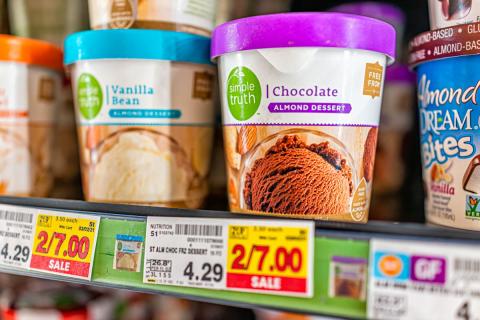Using Advanced Technology to Drive Pricing Decisions

Any savvy grocer knows that using technology, data and analytics can be key to setting themselves apart from competitors in today’s challenging economic landscape. Taking these tools to the next level for price, promotion and markdown optimization, however, is still an often-unexplored avenue for food retailers.
While price, promotion and markdown optimization might seem like no-brainers in the grand scheme of grocery operations, the truth is a large majority of food retailers aren’t taking advantage of these powerful tools. That’s about to change, however, according to Kevin Sterneckert, chief strategy officer for Conway, Ark.-based DemandTec by Acoustic, as more grocers embrace the need to sharpen pricing and promotions amid the rise of e-commerce and unprecedented industry challenges.
[Read more: "Why AI Could Be the Solution Your Store Needs"]
“We’ve had inflation, but we didn’t have supply chain disruptions at the same time,” notes Sterneckert. “We didn’t have labor issues at the same time. We didn’t have issues with supply and retail relationships because products were not available. All of these things are happening at once, and it’s compelling retailers to say ‘I need a better way to manage all of these cost changes and all of these things that are happening.’”
While it’s one thing to have the right prices and the predictive analytics to properly forecast the impacts of strategy adjustments or individual pricing moves, it’s also critical to move faster than the competition, explains Matt Pavich, senior director of retail innovation at Alpharetta, Ga.-based Revionics, an Aptos company that provides artificial intelligence (AI)-powered pricing and promotion optimization software to retailers.
“[T]he best food retailers are adopting leading solutions and best practices to not only price better, but also price faster,” says Pavich, also noting that leveraging optimization can help food retailers find the delicate balance of pricing moves to ensure that consumers in different markets are getting great prices while accounting for cannibalization, halo effects and profitability.
Behind the Solutions
DemandTec by Acoustic offers solutions for price, promotion and markdown optimization, all of which are built on algorithms determined by AI and machine-learning technology. According to Sterneckert, these sophisticated solutions understand all of the interrelationships of products and measurable impacts to demand, therefore giving grocers an accurate understanding of how price will influence consumer behavior.
“We take in all of the transactions that happen at a given location, across every location, all of the competitive data, even inclusive of the vendor information, product information, product attributes, and more,” he explains. “We bring in competitive price data and we create an artificial-intelligence and machine-learning algorithm for each individual SKU at every location.”
Sterneckert adds that these insights give retailers information on how to leverage optimization to improve their competitiveness and their appeal to consumers, as well as their ability to handle pricing moves amid inflation, supply chain disruptions, new store builds, and more. As a result, users of DemandTec by Acoustic’s promotion solution can expect a revenue increase of 1%-12% and a gross margin increase of 5%-20%, while markdown solution users can expect a greater than 10% gross margin increase and a revenue increase of greater than 5%.
Revionics’ base price optimization tool helps retailers simplify the complexity of pricing and gain clarity into the impacts of every price change, making it easier to know what pricing moves make the most sense at any given time. Promotion optimization, meanwhile, simulates outcomes and tailors promotional strategies to the most efficient offers for supporting specific business goals and customer engagement. Markdown optimization allows food retailers to reduce waste and minimize costs while generating greater value and maximizing sell-through.
According to Revionics, its customers average a 5%-9% profit lift soon after launch and see eight to 10 times return on investment (ROI) year after year.
“The ROI on a price optimization solution is an opportunity that retailers simply can’t ignore,” asserts Pavich. “While actual results may vary based on the pricing strategies, priorities and processes enacted, it is safe to say that most food retailers who invest in a price optimization solution drive significant ROI, with a ‘break-even’ often occurring between six months and one year.”

Gaining Momentum
A study from Franklin, Tenn.-based IHL Group shows that prescriptive analytics like those used in pricing and promotion optimization are expected to be rapidly deployed by food retailers in the next year. The research and advisory firm points to inflation-driven changes in consumer behavior and demand that must be met with real-time moves, as well as broad promotions that are often less effective if not personalized, as reasons for the upswell.
While not every grocer can initiate each individual process overnight, Pavich explains that the journey itself is self-funding, with each improvement driving significant benefits that can fund future enhancements. “Becoming a pricing-fluent retailer is a journey that involves critically investing in your people, your processes, your strategies and your technology,” he says.
To get started, DemandTec by Acoustic walks retailers through a carefully orchestrated process, with the recommendation that they choose the one price category that’s their most painful process to begin with — be it promotions, everyday pricing or markdowns. “We can stand these up rather quickly and get the prices on the shelf and the value occurring,” notes Sterneckert. “The value generates increased profit, revenue and volume that you can use to invest in one of the other solutions.”
Regardless of how food retailers get started on their price optimization journey, both Sterneckert and Pavich believe that there’s no time like the present to initiate the processes.
As Pavich points out, “[I]t’s one thing to have the right prices and the predictive analytics to properly forecast the impacts of strategy adjustments or individual pricing moves, but it is also critical to move faster than the competition in an increasingly dynamic and omnichannel retail landscape.”


.jpeg?itok=PPwvSWS4)



